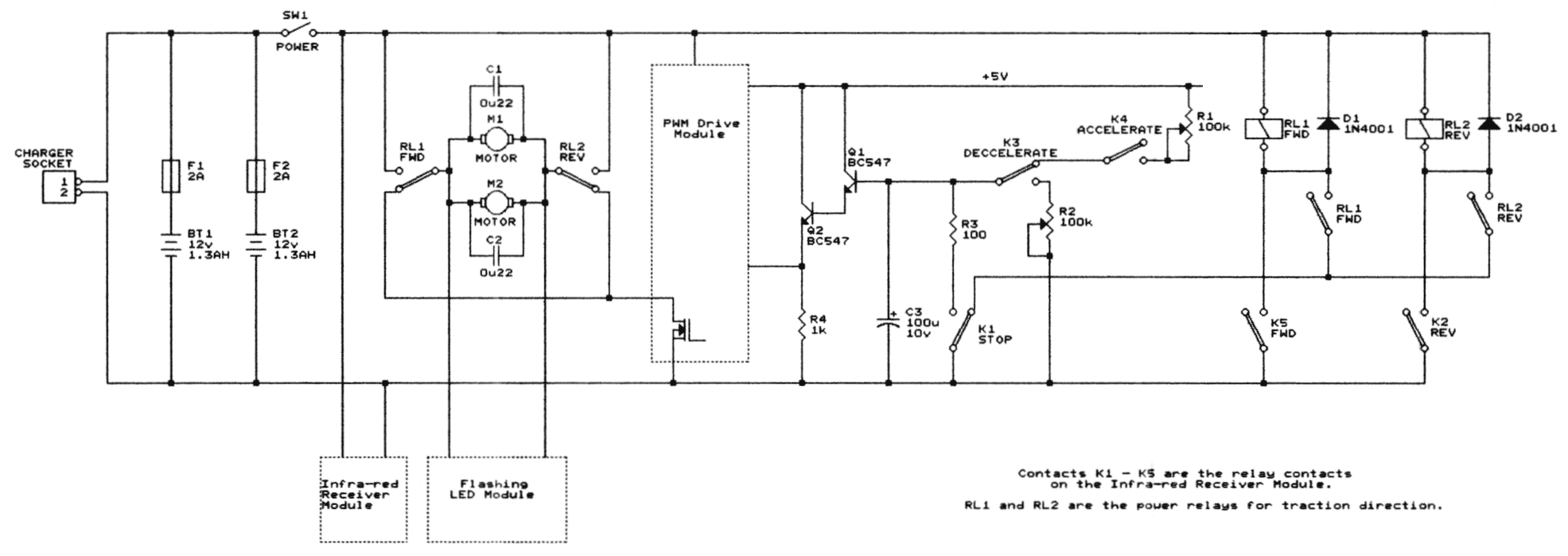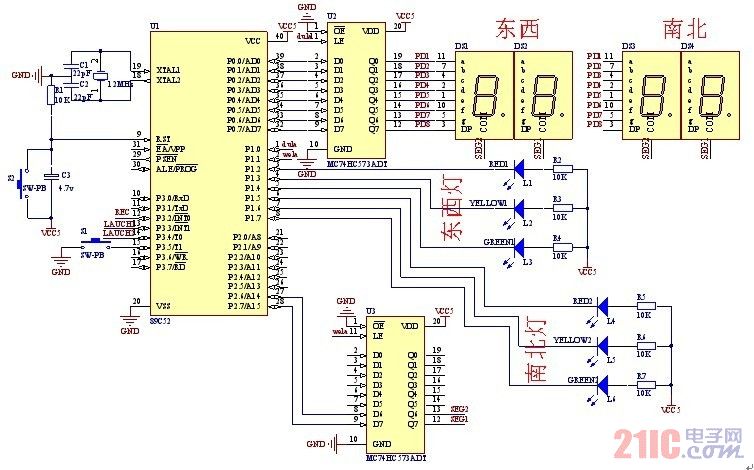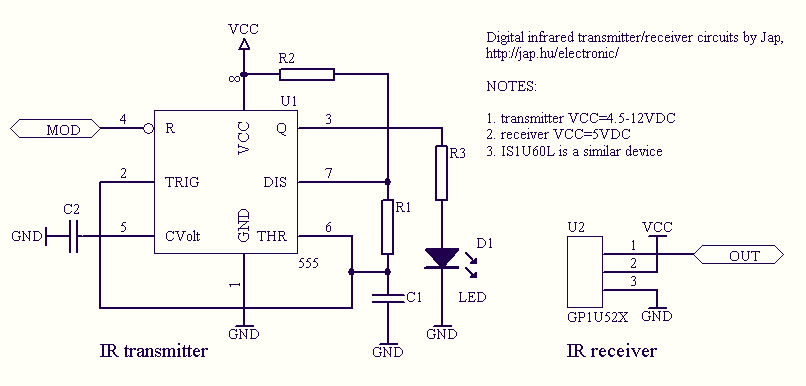
Remote Controlled Locomotive

The prototype for this model is one of a DSG class of 24 locomotives built in 1981 by Toshiba for the New Zealand Railways. These locomotives weigh 56 tonnes and have two diesel engines, providing a total of 750 kW. In more recent years, they have been modified for shunting with a crew of one or two, by the provision of refuges behind the headboards for the safe riding of staff, and a radio-controlled remote system that allows the operator to leave the cab to couple wagons while still being able to drive the locomotive from a distance. The Meccano model is built to a scale of 1:17 and runs on 2.5" gauge track. Two Richards motors with six-speed gearboxes provide the motive power (one per bogie, with only one axle driven on each bogie). The gearing used provides a scale top speed of about 20 km/h while developing enough torque to move six bogie container wagons through four-metre radius reverse curves in a shunting yard. Electronics have been added to enable driving the locomotive in a prototypical manner via remote control. The model is self-powered, as the pointwork in the shunting yard complicates the use of insulated rails for power feeding. The solution involves an infrared (IR) remote control system from Oatley Electronics, originally designed for remote operation of stereo equipment, which consists of a handheld remote transmitter and an 8-channel IR Receiver Module. The IR Receiver Module is interfaced to a Pulse Width Modulation (PWM) drive unit from Dick Smith Electronics, originally designed as a light dimmer or motor speed controller for automotive applications. With a switching capacity of 10A, it easily powers the two Richards motors wired in parallel. Power is supplied by two lead-acid gel cells of 12V, 1.3Ah, wired in parallel, providing sufficient energy for several hours of shunting at exhibitions. The prototype locomotives feature two strobe units on the sloping roof sides of the cab that alternate in double flashes. This is simulated with a digital circuit that drives high-intensity yellow LEDs, wired in parallel with the motors, ensuring the LEDs flash only when the locomotive is in motion. The IR Receiver Module's IR sensor was relocated from the circuit board to a separate piece of stripboard, connected via a two-core coaxial cable. The IR commands are decoded by the module and used to operate eight independent relays, five of which are utilized in this model. The relay contacts are labeled K1 to K5, shown in their rest state (i.e., controller button not pressed). To initiate movement, the appropriate button for 'Forward' or 'Reverse' direction must be pressed on the remote control. This activates the corresponding power relay RL1 or RL2, which self-latches on one of its contacts. The other contact of the power relay establishes the traction motor circuit from the positive supply line, through the motors, to the negative supply line via a MOSFET power transistor in the PWM drive module. A 'Stop' button is provided to release the latched power relay (via the K1 receiver relay), which is essential when changing direction and also offers an instant emergency stop function. Capacitors C1 and C2 are connected across the motor brushes to suppress electrical noise generated by the motors, which could interfere with the electronics. Diodes D1 and D2 are incorporated into the relays to prevent voltage spikes during relay release, which could potentially damage the electronics. The PWM Module regulates the traction motor current by rapidly switching the MOSFET transistor on and off at a fixed frequency with a variable duty cycle.The prototype for this model is one of a `DSG` class of 24 locomotives built in 1981 by Toshiba for the New Zealand Railways. These locomotives weigh 56 tonnes and have two diesel engines, providing a total of 750kW. In more recent years they have been modified for shunting with a crew of one or two, by the provision of `refuges` behind the headbo
ards for the safe riding of staff, and a radio-controlled remote system which allows the operator to leave the cab to couple wagons and still be able to drive the locomotive from a distance. The Meccano model is built to a scale of 1:17 and runs on 2. 5" gauge track. Two Richards motors with six speed gearboxes provide the motive power (one per bogie, with only one axle driven on each bogie).
The gearing used provides a scale top speed of about 20km/h, while developing enough torque to move six bogie container wagons through four-metre radius reverse curves in a shunting yard. I wanted to add electronics to be able to drive the locomotive in prototypical fashion, `by remote`. The model had to be self-powered, as the pointwork in the shunting yard made any idea of insulated rails for power feeding a bit of a nightmare.
The solution came in the form of an infra-red (IR) remote control system from Oatley Electronics. This kit was originally designed for the remote control operation of stereo equipment, and is comprised of a nice handheld remote transmitter unit and an 8-channel IR Receiver Module. The IR Receiver Module is interfaced to a Pulse Width Modulation (PWM) drive unit, a kit from Dick Smith Electronics designed originally as a light dimmer or motor speed controller for use in cars.
With a switching capacity of 10A it easily runs the two Richards motors wired in parallel. Power is supplied by two lead-acid gel cells of 12V, 1. 3Ah, wired in parallel, which store enough energy to give several hours of shunting at an exhibition. The prototype locomotives have two strobe units on the sloping roof sides of the cab, which alternately do a double flash.
I simulated this with a little digital circuit which drives high-intensity yellow LEDs. This circuit is also wired in parallel with the motors, so that the LEDs only flash when the locomotive is moving (as the real ones do). The IR Receiver Module originally had its IR sensor mounted on the circuit board; I removed it to a separate piece of stripboard and connected it to the module via a two-core coaxial cable.
The IR commands are decoded by the module and are used to drive eight independent relays, five of which are used on this model. In the figure the contacts of these relays are labeled K1 to K5, and all are shown in their `rest` state (i.
e. controller button not pressed). To get the model to move, firstly `Forward` or `Reverse` direction must be selected by pushing the appropriate button on the remote control. The corresponding power relay RL1 or RL2 operates and self-latches on one of its contacts. The other contact of the power relay sets up the traction motor circuit from the positive supply line, through the motors, to the negative supply line via a MOSFET power transistor in the PWM drive module.
A `Stop` button is used to release the latched power relay (via the K1 receiver relay), which is necessary when changing direction, and also provides an instant `emergency stop` function. Capacitors C1 and C2 wired across the motor brushes are to suppress the electrical noise created by the motors, which could otherwise interfere with the operation of the electronics.
Diodes D1 and D2 are fitted to the relays to prevent voltage spikes from being generated when the relays release. These spikes could potentially be large enough to damage the electronics if diodes were not fitted. We now need to get the traction motor current going. The PWM Module does this by switching the MOSFET transistor on and off rapidly, at a fixed frequency but variable duty cycle.
This technical t 🔗 External reference
ards for the safe riding of staff, and a radio-controlled remote system which allows the operator to leave the cab to couple wagons and still be able to drive the locomotive from a distance. The Meccano model is built to a scale of 1:17 and runs on 2. 5" gauge track. Two Richards motors with six speed gearboxes provide the motive power (one per bogie, with only one axle driven on each bogie).
The gearing used provides a scale top speed of about 20km/h, while developing enough torque to move six bogie container wagons through four-metre radius reverse curves in a shunting yard. I wanted to add electronics to be able to drive the locomotive in prototypical fashion, `by remote`. The model had to be self-powered, as the pointwork in the shunting yard made any idea of insulated rails for power feeding a bit of a nightmare.
The solution came in the form of an infra-red (IR) remote control system from Oatley Electronics. This kit was originally designed for the remote control operation of stereo equipment, and is comprised of a nice handheld remote transmitter unit and an 8-channel IR Receiver Module. The IR Receiver Module is interfaced to a Pulse Width Modulation (PWM) drive unit, a kit from Dick Smith Electronics designed originally as a light dimmer or motor speed controller for use in cars.
With a switching capacity of 10A it easily runs the two Richards motors wired in parallel. Power is supplied by two lead-acid gel cells of 12V, 1. 3Ah, wired in parallel, which store enough energy to give several hours of shunting at an exhibition. The prototype locomotives have two strobe units on the sloping roof sides of the cab, which alternately do a double flash.
I simulated this with a little digital circuit which drives high-intensity yellow LEDs. This circuit is also wired in parallel with the motors, so that the LEDs only flash when the locomotive is moving (as the real ones do). The IR Receiver Module originally had its IR sensor mounted on the circuit board; I removed it to a separate piece of stripboard and connected it to the module via a two-core coaxial cable.
The IR commands are decoded by the module and are used to drive eight independent relays, five of which are used on this model. In the figure the contacts of these relays are labeled K1 to K5, and all are shown in their `rest` state (i.
e. controller button not pressed). To get the model to move, firstly `Forward` or `Reverse` direction must be selected by pushing the appropriate button on the remote control. The corresponding power relay RL1 or RL2 operates and self-latches on one of its contacts. The other contact of the power relay sets up the traction motor circuit from the positive supply line, through the motors, to the negative supply line via a MOSFET power transistor in the PWM drive module.
A `Stop` button is used to release the latched power relay (via the K1 receiver relay), which is necessary when changing direction, and also provides an instant `emergency stop` function. Capacitors C1 and C2 wired across the motor brushes are to suppress the electrical noise created by the motors, which could otherwise interfere with the operation of the electronics.
Diodes D1 and D2 are fitted to the relays to prevent voltage spikes from being generated when the relays release. These spikes could potentially be large enough to damage the electronics if diodes were not fitted. We now need to get the traction motor current going. The PWM Module does this by switching the MOSFET transistor on and off rapidly, at a fixed frequency but variable duty cycle.
This technical t 🔗 External reference




